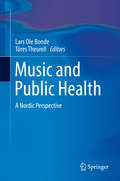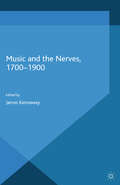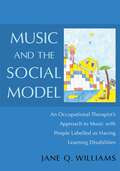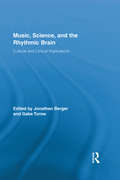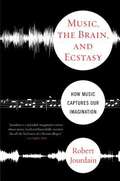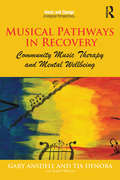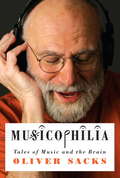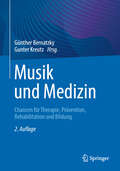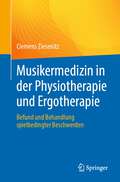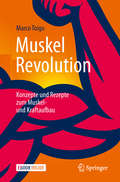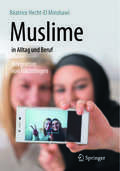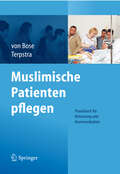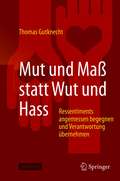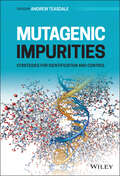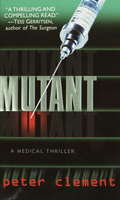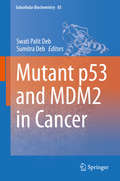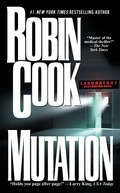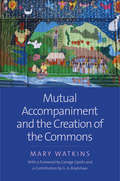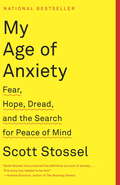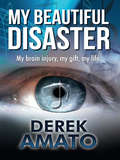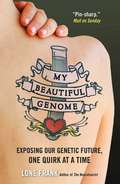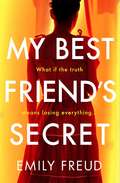- Table View
- List View
Music and Public Health: A Nordic Perspective
by Lars Ole Bonde Töres TheorellFrom the Nordic countries (Denmark, Norway, Sweden and Finland) comes an exciting source of theoretical approaches, epidemiological findings, and real-life examples regarding the therapeutic and health-enhancing effects of music. Experts across fields including psychology, neurology, music therapy, medicine, and public health review research on the benefits of music in relieving physiological, psychological, and socioemotional dysfunction. Chapters link musical experiences (listening and performing, as well as involvement in movement, dance, and theatre) to a wide range of clinical and non-clinical objectives such as preventing isolation, regulating mood, reducing stress and its symptoms, and treating dementia. And the book’s section on innovative music-based interventions illustrates opportunities for incorporating musical activities into public health programs. Among the topics covered are: · Associations between the use of music, cultural participation and health-related outcomes in adult Scandinavian populations · Music practice and emotion handling · How music translates itself biologically in the body · Music as a forum for social-emotional health · Participation and partnership as core concepts in music and public health · Music therapy as health promotion for mothers and children at a public health clinic Music and Public Health will gain interested readers among researchers, teachers, students, and clinicians in the fields of music education and therapy, as well as researchers and students of public health who are interested in the influence of culture and the arts. The book also will be relevant to administrators in public health services.
Music and the Nerves, 1700-1900
by James KennawayThe relationship between music and the nervous system is now the subject of intense interest for scientists and people in the humanities, but this is by no means a new phenomenon. This volume sets out the history of the relationship between neurology and music, putting the advances of our era into context.
Music and the Social Model: An Occupational Therapist's Approach to Music with People Labelled as Having Learning Disabilities
by Jane Williams Rachel PurtellMusic has always been an essential part of what it is to be human and yet not everyone has access to the music-based opportunities others take for granted. Motivated by the belief that individuals are disabled by society rather than any impairment they might have, Jane Williams sets out to show how someone with learning difficulties can engage with music in as many diverse and fulfilling ways as the rest of their community and generation. This practical guide will equip you with everything you need to know to help empower people with learning difficulties to experience and enjoy music, meaningfully. It sets out activity ideas in the context of existing Occupational Therapy models and offers a host of tips, resources and ready-to-use themed lesson plans to inspire and enrich your practice. There are also many practical examples and real-life success stories that show how to put the theory into practice, including downloadable tracks composed and performed by The LA Buskers, a band Jane works with. Accessible, practical and inspirational, the unique approaches described in this book will be of immeasurable interest to occupational therapists, social care workers responsible for planning and delivering activity programmes as well as community musicians.
Music, Science, and the Rhythmic Brain: Cultural and Clinical Implications (Routledge Research in Music)
by Jonathan Berger Gabe TurowThis book studies the effects of repetitive musical rhythm on the brain and nervous system, and in doing so integrates diverse fields including ethnomusicology, psychology, neuroscience, anthropology, religious studies, music therapy, and human health. It presents aspects of musical rhythm and biological rhythms, and in particular rhythmic entrainment, in a way that considers cultural context alongside theoretical research and discussions of potential clinical and therapeutic implications. Considering the effects of drumming and other rhythmic music on mental and bodily functioning, the volume hypothesizes that rhythmic music can have a dramatic impact on mental states, sometimes catalyzing profound changes in arousal, mood, and emotional states via the stimulation of changes in physiological functions like the electrical activity in the brain. The experiments presented here make use of electroencephalography (EEG), galvanic skin response (GSR), and subjective measures to gain insight into how these mental states are evoked, what their relationship is to the music and context of the experience, and demonstrate that they are happening in a consistent and reproducible fashion, suggesting clinical applications. This comprehensive volume will appeal to scholars in cognition, ethnomusicology, and music perception who are interested in the therapeutic potential of music.
Music, The Brain, And Ecstasy
by Robert JourdainWhat makes a distant oboe's wail beautiful? Why do some kinds of music lift us to ecstasy, but not others? How can music make sense to an ear and brain evolved for detecting the approaching lion or tracking the unsuspecting gazelle? Lyrically interweaving discoveries from science, psychology, music theory, paleontology, and philosophy, Robert Jourdian brilliantly examines why music speaks to us in ways that words cannot, and why we form such powerful connections to it. In clear, understandable language, Jourdian expertly guides the reader through a continuum of musical experience: sound, tone, melody, harmony, rhythm, composition, performance, listening, understanding--and finally to ecstasy. Along the way, a fascinating cast of characters brings Jourdian's narrative to vivid life: "idiots savants" who absorb whole pieces on a single hearing, composers who hallucinate entire compositions, a psychic who claims to take dictation from long-dead composers, and victims of brain damage who can move only when they hear music. Here is a book that will entertain, inform, and stimulate everyone who loves music--and make them think about their favorite song in startling new ways.
Musical Pathways in Recovery: Community Music Therapy and Mental Wellbeing (Music and Change: Ecological Perspectives)
by Gary Ansdell Tia DeNora"Music triggered a healing process from within me. I started singing for the joy of singing myself and it helped me carry my recovery beyond the state I was in before I fell ill nine years ago to a level of well-being that I haven't had perhaps for thirty years." This book explores the experiences of people who took part in a vibrant musical community for people experiencing mental health difficulties, SMART (St Mary Abbotts Rehabilitation and Training). Ansdell (a music therapist/researcher) and DeNora (a music sociologist) describe their long-term ethnographic work with this group, charting the creation and development of a unique music project that won the 2008 Royal Society for Public Health Arts and Health Award. Ansdell and DeNora track the 'musical pathways' of a series of key people within SMART, focusing on changes in health and social status over time in relation to their musical activity. The book includes the voices and perspectives of project members and develops with them a new understanding of how music promotes their health and wellbeing. A contemporary ecological understanding of 'music and change' is outlined, drawing on and further developing theory from music sociology and Community Music Therapy. This innovative book will be of interest to anyone working in the mental health field, but also music therapists, sociologists, musicologists, music educators and ethnomusicologists. This volume completes a three part 'triptych', alongside the other volumes, Music Asylums: Wellbeing Through Music in Everyday Life, and How Music Helps: In Music Therapy and Everyday Life.
Musicophilia: Tales Of Music And The Brain (Picador Classic Ser.)
by Oliver SacksRevised and ExpandedWith the same trademark compassion and erudition he brought to The Man Who Mistook His Wife for a Hat, Oliver Sacks explores the place music occupies in the brain and how it affects the human condition. In Musicophilia, he shows us a variety of what he calls "musical misalignments." Among them: a man struck by lightning who suddenly desires to become a pianist at the age of forty-two; an entire group of children with Williams syndrome, who are hypermusical from birth; people with "amusia," to whom a symphony sounds like the clattering of pots and pans; and a man whose memory spans only seven seconds-for everything but music. Illuminating, inspiring, and utterly unforgettable, Musicophilia is Oliver Sacks' latest masterpiece.From the Trade Paperback edition.
Musik und Medizin: Chancen für Therapie, Prävention, Rehabilitation und Bildung
by Günther Bernatzky Gunter KreutzDieses Buch beleuchtet die Wirkungen von Musik auf Gesundheit, Wohlbefinden und Lebensqualität aus der Sicht interdisziplinärer, musikwissenschaftlicher und medizinischer Forschung. Hochrangige Expert*innen aus vielfältigen Fachgebieten stellen die wissenschaftlichen Grundlagen für medizinische, therapeutische, pädagogische und andere Anwendung vor. Inhaltlich spannt es den Bogen von den psychophysiologischen Grundlagen emotionaler Wirkungen des Musikhörens bis hin zu musikmedizinischen und -therapeutischen Interventionen. Musik erweist sich vielfach als äußerst wirksame, nahezu nebenwirkungsfreie und vergleichsweise kostengünstige unterstützende Strategie für Prävention, Therapie und Rehabilitation in vielen medizinischen Fachbereichen.Ein breites Spektrum musikalischer Aktivitäten einschließlich Musikhören, Laienmusizieren, Chorsingen, Tanzen und verschiedene Formen musiktherapeutischer Strategien steht den Erfordernissen unterschiedlicher Zielgruppen, individuellen Unterschieden, Vorlieben und kulturellen Hintergründen gegenüber. Die Neuauflage wurde aktualisiert und mit Inhalten zu COVID 19 und einer neuen Sektion zu gesundheitlichen Belastungen durch Musik erweitert.Ärzt*innen und medizinisches Personal in Sozial- und Pflegeberufen erhalten profunde Informationen über Chancen und Grenzen musikbezogener Angebote. Die Kapitel eignen sich ebenso als Einstiege für Wissenschaftler*innen zahlreicher Fachrichtungen aus Sozial-, Natur- und Geisteswissenschaft.
Musikermedizin in der Physiotherapie und Ergotherapie: Befund und Behandlung spielbedingter Beschwerden
by Clemens ZiesenitzIn diesem Buch werden die theoretischen Grundlagen der Musikermedizin sowie die besonderen Anforderungen und Belastungen von professionellen Musikerinnen und Musikern praxisorientiert vermittelt. Der herausfordernde Berufsalltag kann durch die asymmetrische Haltung, der statischen Beanspruchung am Instrument oder durch langanhaltende, repetitive Bewegungsabfolgen zu muskulären Dysbalancen oder Überlastungssyndromen führen. Der Autor beschreibt anhand häufiger Störungsbilder die Befunderhebung und Behandlung in der Physiotherapie und Ergotherapie Das Praxisbuch erweitert das Wissen auf diesem spezialisierten Gebiet und hilft dabei, Musikerinnen und Musiker bestmöglich zu unterstützen, um typische Beschwerden vorzubeugen und ihre Leistungsfähigkeit zu steigern.
MuskelRevolution: Konzepte und Rezepte zum Muskel- und Kraftaufbau
by Marco ToigoWie Sie effektiv Muskeln aufbauen In diesem ebenso informativen wie praxisnahen Buch, das auf dem neuesten Stand der Muskelforschung basiert, entschlüsselt Marco Toigo, welche Faktoren für einen erfolgreichen Muskel- und Kraftaufbau entscheidend sind. Zudem stellt er anschaulich dar, welche praktischen und wissenschaftlich fundierten Konsequenzen sich für Ihr Trainings- und Ernährungsverhalten ergeben. Dieses Werk bietet somit zeitgleich einen praktischen Leitfaden wie auch eine wissenschaftliche Erklärung zum „Wie“ bzw. „Warum“ eines effektiven und effizienten Krafttrainings. Die nun vorliegende 2. Auflage ist vollständig überarbeitet und bietet folgende Erweiterungen:Neueste wissenschaftliche Erkenntnisse zum Effekt von Krafttraining und Nahrungsprotein auf die Kurzzeit- und Langzeit-Proteinsynthese im Skelettmuskel Präsentation eines universellen Modells zur trainingsinduzierten Muskelhypertrophie Training nach neuromuskulären Kompartimenten Viele neue ergänzende Texte zu Begleitthemen wie Fettabbau und Herz-/Kreislauf-Training Auf den Punkt gebracht: Ergänzende KurzzusammenfassungenMarco Toigo entlarvt Fitness-Mythen, erklärt, was beim Muskelaufbau wirklich passiert, und verrät, welche Denkfehler Sie beim Training bremsen. Unterhaltsam und intelligent, mit praktischen Mucki-Tipps von Dr. Muscle. 20 MinutenEin hervorragender Begleiter für Alle, die sich intensiv oder professionell mit Fitness und Krafttraining befassen. boersenblatt.net
Muslim Midwives
by Avner GiladiThis book reconstructs the role of midwives in medieval to early modern Islamic history through a careful reading of a wide range of classical and medieval Arabic sources. The author casts the midwife's social status in premodern Islam as a privileged position from which she could mediate between male authority in patriarchal society and female reproductive power within the family. This study also takes a broader historical view of midwifery in the Middle East by examining the tensions between learned medicine (male) and popular, medico-religious practices (female) from early Islam into the Ottoman period and addressing the confrontation between traditional midwifery and Western obstetrics in the first half of the nineteenth century.
Muslime in Alltag und Beruf: Integration von Flüchtlingen
by Béatrice Hecht-El MinshawiIn diesem Buch erfahren alle, die Flüchtlingen und Asylbewerbern begegnen – privat wie beruflich –, wie sie zu einem guten Miteinander beitragen können. In Deutschland gibt es viele Neubürger und Migranten: Exilanten, Flüchtlinge und Asylbewerber. Ein Großteil kommt aus islamischen Gesellschaften und ist mit manchen anderen Normen und Werten aufgewachsen. Deshalb ist davon auszugehen, dass wir immer öfter Muslimen in Beruf und Alltag begegnen. Sie gehören zu uns. Damit das Zusammenleben und die Zusammenarbeit gelingt, ist ein fundiertes interkulturelles Wissen notwendig: kulturelle Gemeinsamkeiten und Unterschiede, Mentalitäten, Verhaltensregeln, Kommunikationsstrategien und Tabus. Dieses Praxisbuch hilft, Muslime zu verstehen und vermittelt Ideen zum gemeinsamen Handeln – mit zahlreichen Fallbeispielen und Checklisten. Es richtet sich als Beratungsbuch und Arbeitsgrundlage an alle Personen im deutschsprachigen Raum, die mit Muslimen zu tun haben, in privaten und öffentlichen Einrichtungen wie Behörden und Schulen und in Betrieben.
Muslimische Patienten pflegen
by Alexandra Von Bose Jeanette TerpstraIn Deutschland leben ca. 4 Millionen Muslime und die Zahl der älteren Migranten steigt. So versorgen beruflich Pflegende immer häufiger kranke und pflegebedürftige Menschen, die einen anderen kulturellen Hintergrund haben. In der medizinischen und pflegerischen Betreuung kommt es zwischen Migranten und Pflegepersonal durch die kulturellen Unterschiede oft zu Konfliktsituationen und Störungen im Behandlungs- und Stationsablauf. Auslöser sind Stereotype, Unwissenheit und Verständigungsschwierigkeiten. Die Autorinnen unterstützen mit dieser Praxisfibel einen konfliktfreien Umgang mit muslimischen Migranten. An einzelnen Fallsituationen aus dem Klinik- und Pflegealltag werden Probleme dargestellt, kulturelle Hintergründe erläutert und Handlungsanregungen vorgeschlagen. Pflegende erhalten konkrete Tipps wie sie häufig auftretende Stress- und Konfliktsituationen mit muslimischen Patienten meistern. Das Kapitel über die Grundlagen der islamischen Kultur, z.B. zum Wertesystem, Rituale, Rollenverhalten, Krankheitsverständnis, fördert das Verständnis für die andere Kultur und hilft Konflikten vorzubeugen. Einfach und praktisch: Ein speziell entwickelter Anamnesebogen für muslimische Patienten erleichtert es Pflegenden schon bei der Aufnahme auf die besonderen Bedürfnisse einzugehen und eine konfliktfreie Betreuung in der Einrichtung vorzubereiten. Ein Glossar erläutert die wichtigsten islamischen Begriffe. Für beruflich Pflegende im Krankenhaus und in Pflegeeinrichtungen, die sich auf die Bedürfnisse von Migranten einlassen möchten. Geeignet für die interne Fortbildung, die Praxisanleitung aber auch für den Sozialdienst und ehrenamtliche Besuchsdienste.
Mut und Maß statt Wut und Hass: Ressentiments angemessen begegnen und Verantwortung übernehmen
by Thomas GutknechtDieses Sachbuch lädt ein, in Zeiten äußerer Unruhe und Unsicherheit darüber nachzudenken, was das gute Leben bedroht, um dann in angemessenem Rahmen Verantwortung übernehmen zu lernen. Ein Schlüssel zum Verständnis persönlicher wie gesellschaftlicher Katastrophen ist das Wissen um das Ressentiment. Ressentiments werden befeuert durch Ängste, genährt durch Bedenken- und Gedankenlosigkeit. Folgen sind Kränkung, Schuldgefühle, Scham und Angst. Dieses Buch zeigt die Zusammenhänge auf und lädt ein, zu bedenken und im Fühlen zu verankern: Wir gehören nicht der Angst und können dem Ressentiment begegnen. Wie? Mit Mut in der Besorgnis und mit einem besonnenen Denken, das das Unrechtsempfinden aufzulösen vermag und Versöhnung anbahnen kann. Lesen Sie, wie Sie wacher werden und reifen. Verstehen Sie das Wesen von Ressentiment und warum es gute Gründe für Hoffnung gibt. Lassen Sie sich ermutigen, Verantwortung zu übernehmen und zu einem Vertrauen zu finden, das Menschen verbindet. Dies ist kein Ratgeber, der Tipps und Tricks verrät, und doch sind die Auswirkungen dieser Lektüre psychologisch, nah, spürbar. Aus dem Inhalt: I Einleitung – II Ressentiment – III Angst – IV Mut – V Hoffnung – VI Verantwortung. Der Autor: Thomas Gutknecht ist Philosoph und Theologe und leitet das Logos-Institut für Philosophische Praxis. Seine Themen sind z. B. Lebenskunst, Sozialphilosophie, Philosophie der Zeit und der Gesundheit.
Mutagenic Impurities: Strategies for Identification and Control
by Andrew TeasdaleLearn to implement effective control measures for mutagenic impurities in pharmaceutical development In Mutagenic Impurities: Strategies for Identification and Control, distinguished chemist Andrew Teasdale delivers a thorough examination of mutagenic impurities and their impact on the pharmaceutical industry. The book incorporates the adoption of the ICH M7 guideline and focuses on mutagenic impurities from both a toxicological and analytical perspective. The editor has created a primary reference for any professional or student studying or working with mutagenic impurities and offers readers a definitive narrative of applicable guidelines and practical, tested solutions. It demonstrates the development of effective control measures, including chapters on the purge tool for risk assessment. The book incorporates a discussion of N-Nitrosamines which was arguably the largest mutagenic impurity issue ever faced by the pharmaceutical industry, resulting in the recall of Zantac and similar drugs resulting from N-Nitrosamine contamination. Readers will also benefit from the inclusion of: A thorough introduction to the development of regulatory guidelines for mutagenic and genotoxic impurities, including a historical perspective on the development of the EMEA guidelines and the ICH M7 guideline An exploration of in silico assessment of mutagenicity, including use of structure activity relationship evaluation as a tool in the evaluation of the genotoxic potential of impurities A discussion of a toxicological perspective on mutagenic impurities, including the assessment of mutagenicity and examining the mutagenic and carcinogenic potential of common synthetic reagents Perfect for chemists, analysts, and regulatory professionals, Mutagenic Impurities: Strategies for Identification and Control will also earn a place in the libraries of toxicologists and clinical safety scientists seeking a one-stop reference on the subject of mutagenic impurity identification and control.
Mutant (Dr. Richard Steele #1)
by Peter ClementFormer ER doctor Peter Clement blends electrifying human drama with the suspense of top-notch medical thrillers. With Mutant he has written one of his most gripping, utterly chilling novels to date. On an isolated stretch of highway in Oahu, a woman cradles her dying son in her arms. In the days that follow, an autopsy draws a shocking conclusion: the boy, his lungs filled with blood, died of a disease previously found only in birds. On the other side of the globe, Dr. Richard Steele, a burned-out ER doctor is being recruited into a movement to examine the hazards of genetically modified foods, a job that takes him to an explosive conference in Hawaii. Spearheaded by a charismatic female doctor, the anti-bioengineering movement is gathering steam. While a powerful company is using genetic breakthroughs to create disease-resistant super crops, activists warn that new DNA strains will wreak havoc on the environment. But no one suspects that the controversy is masking a far more frightening human threat-one that could lead to the deadliest weapon of mass destruction ever unleashed upon the world. . . .
Mutant p53 and MDM2 in Cancer
by Swati Palit Deb Sumitra DebThis book provides the readers with an overview of research on p53, which has been shown to play a role in numerous crucial biological pathways in normal and cancer cells. Leading scientist in the field, who have all made direct contributions to the understanding of the molecular events underpinning p53 function, have been invited to contribute the various chapters, which discuss the current knowledge of the signaling cascades that are activated by mutations in p53 and overexpression of MDM2, frequently found in human cancer and are major causes of oncogenesis. This book features chapters on the molecular basis of oncogenesis induced by gain of function mutation of p53, signaling pathways induced by MDM2 overexpression, control of mutant or wild-type p53 function by MDM2 and MDMX, p53 mutation in hereditary cancer and structural aspects that activate mutant p53 which can be targeted by drug therapy. This book should be useful for scientists at all levels.
Mutation
by Robin CookIn Mutation, Robin Cook's masterpiece of techno-medical suspense, Dr. Cook tells a story as chilling and real as today's headlines. <P><P> On the forefront of surrogate parenting and genetic research, it is the explosive tale of a brilliant doctor who sought to create the son of his dreams--and invented a living nightmare...
Mutual Accompaniment and the Creation of the Commons
by Mary WatkinsA landmark book that maps a radical model not only for the “helping” professions but for the work of solidarity This timely and pathbreaking volume maps a radical model of accompaniment, exploring its profound implications for solidarity. Psychosocial and ecological accompaniment is a mode of responsive assistance that combines psychosocial understanding with political and cultural action. Accompaniment—grounded in horizontality, interdependence, and potential mutuality—moves away from hierarchical and unidirectional helping-profession approaches that decontextualize suffering. Watkins envisions a powerful paradigm of mutual solidarity with profound implications for creating commons in the face of societal division and indifference to suffering.
Muziek en bewegen bij dementie
by Annemieke Vink Helma Erkelens Louwke MeinardiVeel van onze herinneringen zijn gekoppeld aan muziek. Dat geldt voor hoogtepunten als verliefd zijn en trouwen, en ook gebeurtenissen uit onze kindertijd zijn vaak verbonden met muziek. Het luisteren naar muziek levert voor mensen met dementie plezierige momenten op. Een bekende melodie als `Het dorp' van Wim Sonneveld bijvoorbeeld, brengt ze weer even terug in de tijd van toen.Muziek en bewegen bij dementie laat zien hoe je met eenvoudige middelen kunt bijdragen aan meer welbevinden en kwaliteit van leven: het zingen van een liedje tijdens het wassen, zachte muziek bij het opstaan, een dansje in de huiskamer, even naar buiten. Als praten niet meer kan, is nog wel contact mogelijk via muziek en bewegen.Dit boek is rijk gevuld met tips en voorbeelden voor verzorgenden, mantelzorgers en activiteitenbegeleiders, en beschrijft voor het management de wellicht benodigde omslag in denken en doen.Annemieke Vink (psycholoog) doceert Theorie muziektherapie aan het ArtEZ Conservatorium Enschede. Zij doet onder andere onderzoek naar de effecten van muziektherapie bij mensen met dementie. Helma Erkelens (historica) en Louwke Meinardi (socioloog) zijn freelance journalist/tekstschrijver en communicatieadviseur. Ze zijn beiden gespecialiseerd in zorg, met name in gezond en actief ouder worden en zorg voor ouderen.De tweede druk is inhoudelijk niet gewijzigd ten opzichte van de eerste druk.
My Age of Anxiety: Fear, Hope, Dread, and the Search for Peace of Mind
by Scott StosselA riveting, revelatory, and moving account of the author's struggles with anxiety, and of the history of efforts by scientists, philosophers, and writers to understand the condition <P><P>As recently as thirty-five years ago, anxiety did not exist as a diagnostic category. Today, it is the most common form of officially classified mental illness. Scott Stossel gracefully guides us across the terrain of an affliction that is pervasive yet too often misunderstood. Drawing on his own long-standing battle with anxiety, Stossel presents an astonishing history, at once intimate and authoritative, of the efforts to understand the condition from medical, cultural, philosophical, and experiential perspectives. <P><P>He ranges from the earliest medical reports of Galen and Hippocrates, through later observations by Robert Burton and Søren Kierkegaard, to the investigations by great nineteenth-century scientists, such as Charles Darwin, William James, and Sigmund Freud, as they began to explore its sources and causes, to the latest research by neuroscientists and geneticists. <P><P>Stossel reports on famous individuals who struggled with anxiety, as well as on the afflicted generations of his own family. His portrait of anxiety reveals not only the emotion's myriad manifestations and the anguish anxiety produces but also the countless psychotherapies, medications, and other (often outlandish) treatments that have been developed to counteract it. <P><P> Stossel vividly depicts anxiety's human toll--its crippling impact, its devastating power to paralyze--while at the same time exploring how those who suffer from it find ways to manage and control it. My Age of Anxiety is learned and empathetic, humorous and inspirational, offering the reader great insight into the biological, cultural, and environmental factors that contribute to the affliction.
My Beautiful Disaster: My Brain Injury, My Gift, My Life
by Derek AmatoDerek Amato's reflections in My Beautiful Disaster provide rare insight into what people with extraordinary gifts see, think, feel and do; pose questions about the potential to tap into previously undetected abilities and spotlight the 'silent epidemic' of head trauma. His experiences also make vivid some the challenges faced by those living with autism and other neurological disorders and hint at the possibility we all have more in common than we think. Readers enchanted by autistic savant, Daniel Tammet's eloquent Born On A Blue Day, will welcome another multi-layered, first person account of what is to live with a remarkable condition. Uniquely, having spent his life as a "neurotypical" Amato's tale relates the before and after of 'the gift'; his voice at times resonating with incredulity at what has happened and what the eventual cost may be.
My Beautiful Genome: Exposing Our Genetic Future, One Quirk at a Time
by Lone FrankWhat if you could predict your future - which political party you will vote for, what kind of person you will marry, which disease will end your life, whether your blue mood will fester into something more troubling, even debilitating. Would you want to know? Taking a uniquely intimate and cheeky approach to the personal genomics revolution, internationally acclaimed science writer Lone Frank swabs up her genetic code to explore who any of us are in the days when a catalogue of your full six billion DNA building blocks is available for $10,000 and the local Walgreens offers genetic screening tests to anyone. She challenges the august Nobel Prize winners and the hyperactive business mavericks who are pushing to map and decipher every fetus's genome within the next decade. She tests the potential to detect diseases early, as well as our capacity to develop chronic anxieties when our DNA is seen as a death sentence. She ponders whether personality, including her own above-average irritability and non-conformity, can really be reduced to biochemistry. And she prods the psychologists who hope to uncover just how much or how little our environment will matter in the new genetic century - a quest made all the more gripping as Frank considers her family's and her own struggles with depression. At turns compellingly candid and irreverently insightful, Frank provides the first truly personal account of the new science of consumer-led genomics - and to what extent our genes determine our destiny. Lone Frank is the author of The Neurotourist: Postcards from the Edge of Brain Science (ISBN 9781851687961). She holds a PhD in neurobiology and was previously a research scientist working in the biotechnology industry in the United States. An award-winning science journalist and TV documentary presenter, she has written for such publicationsn as Scientific American, Science, and Nature Biotechnology and is a frequent speaker at venues including Harvard Medical School, the Library of Congress, the Royal Society, and TED.
My Best Friend's Secret: a page-turning must-read debut thriller
by Emily FreudHow do you escape a past you can't remember?'Had me gripped from the start' 5* reader review'An outstanding debut' 5* reader review'Such a mega page-turner' 5* reader reviewKate Sullivan has a beautiful home, a job she loves and a handsome fiancé: all she'd ever dreamed of since getting sober and painstakingly piecing her life back together.But a chance encounter with her old best friend Becky threatens Kate's newfound and fragile happiness. Kate remembers nothing of their last drunken night out, the night Becky broke off their friendship without warning or explanation.With Becky back in her life, Kate is desperate to make amends for the past. For the closure she craves, Kate needs to know what she did that ruined everything. But what if the truth is worse than Kate could have imagined?'A clever tale of how our demons shape our lives' ALEXANDRA SHULMAN'Gut-wrenching and powerful' CHARLOTTE DUCKWORTH'Beautiful writing and devastating twists' MIRANDA SMITH'A real, clever page-turner. Dare I say addictive' TINA BAKER***Previously published as Closure***
My Best Friend's Secret: a page-turning must-read debut thriller
by Emily FreudHow do you escape a past you can't remember?'Had me gripped from the start' 5* reader review'An outstanding debut' 5* reader review'Such a mega page-turner' 5* reader reviewKate Sullivan has a beautiful home, a job she loves and a handsome fiancé: all she'd ever dreamed of since getting sober and painstakingly piecing her life back together.But a chance encounter with her old best friend Becky threatens Kate's newfound and fragile happiness. Kate remembers nothing of their last drunken night out, the night Becky broke off their friendship without warning or explanation.With Becky back in her life, Kate is desperate to make amends for the past. For the closure she craves, Kate needs to know what she did that ruined everything. But what if the truth is worse than Kate could have imagined?'A clever tale of how our demons shape our lives' ALEXANDRA SHULMAN'Gut-wrenching and powerful' CHARLOTTE DUCKWORTH'Beautiful writing and devastating twists' MIRANDA SMITH'A real, clever page-turner. Dare I say addictive' TINA BAKER***Previously published as Closure***
